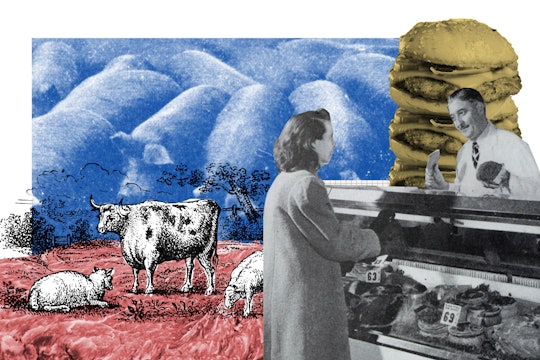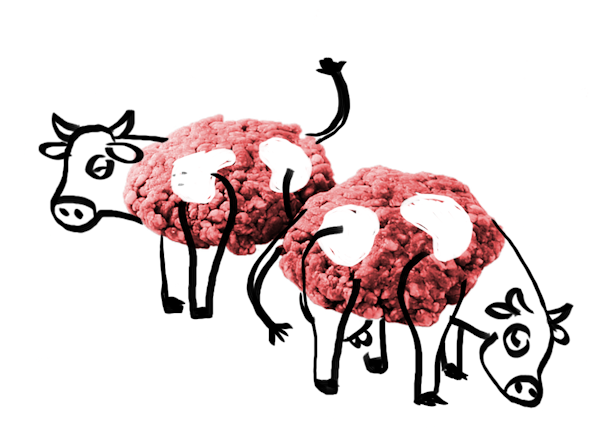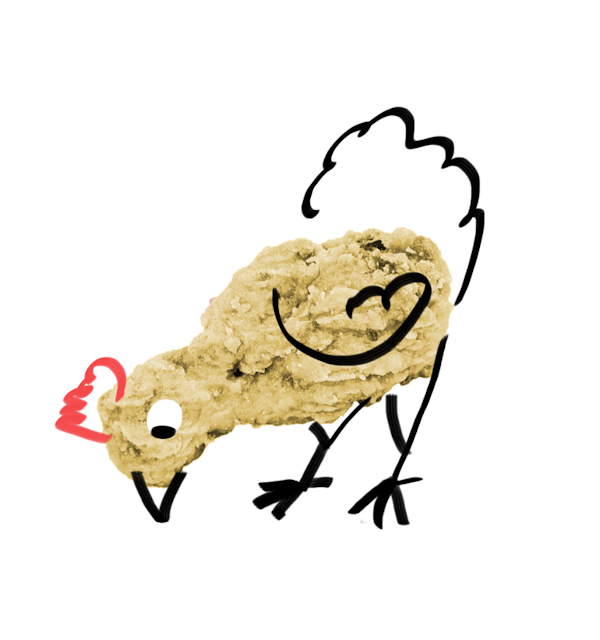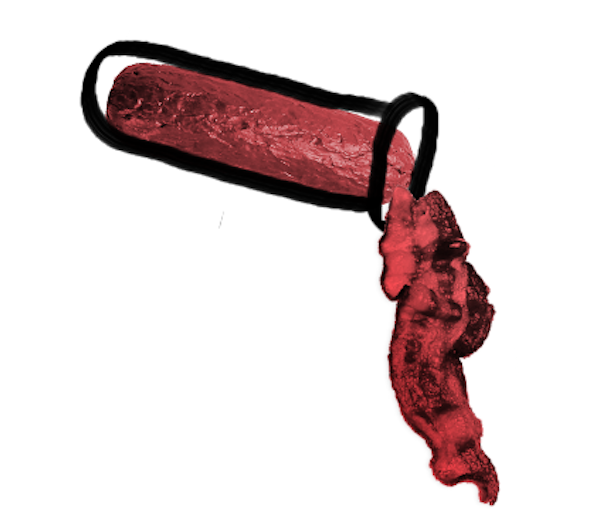Chapter 1
The Dietary Reckoning

Allan Lasser
In the future, how will we buy meat?
Humans will likely eat meat for a long time. Meat consumption is increasing worldwide and will probably continue to grow in the near future. Will we be able to meet this growing demand sustainably and economically? Proponents of meat grown in a lab, aka "cultured meat" think so. Will the world embrace cultured meat? Does it even qualify as "meat" at all? Many questions facing the carnivorous world do not have easy answers.
In the future, analysts agree that people will be producing—and eating—a lot more meat.
The United Nations Food and Agriculture Organization (FAO) has found that the consumption of meat has increased in nearly every single geographical region worldwide since 1960. Consensus from studies by the FAO, along with other researchers, is that by 2050, meat consumption will increase by 62 to 144 percent. A major driver for this increase is something called Bennet's Law, an economic theory that suggests as people become richer, they begin to eat a more diverse diet, including more vegetables, more meat, and less carbohydrates. (This diversity also accounts for a projected increase in consumption of meat substitutes.)
But a higher demand for meat doesn't necessarily translate into more hamburgers. Intriguingly, researchers have found that Americans are actually eating twice as much poultry now than they were in the 1970s, and more processed meat than beef. These changes are visible even just walking down the refrigerated aisle in your local grocery store. Sales of more traditional meat analogues, like tofu or Quorn, are on the rise, and other less conventional sources of protein such as insects have made it onto supermarket shelves in several Western countries.

In the near future, perhaps in a decade or two, many experts agree that, at least in developed countries, shoppers are going to be presented with an increased number of meat choices—whether sourced traditionally from animals, processed from plant-based protein, or grown in a lab. While the first cultured meat burger cost a whopping $325,000 USD in 2013, lab meat companies today insist that their products will soon cost the same, or even less, than traditional meat alternatives. In an interview with FastCompany, Yaakov Nahmias, founder of the lab meat startup Future Meat Technologies, went so far as to claim that in the future, "the burgers that we’re going to put on the grill, and the chicken nuggets that we’re going to eat at McDonald’s, and the barbecued chicken that we’re going to eat in Chipotle, is mainly going to be cultured meat," suggesting that conventional meat will become a niche product sold only in more expensive restaurants.
But if these predictions play out and cultured meat reaches supermarket shelves in the next decade, how will consumers know what they're buying? Will cells grown in a lab be labeled "beef?" The U.S. Cattlemen's Association is concerned enough about the latent competition that they recently sent a petition to the US Department of Agriculture (USDA). It specifically defines meat as a product derived from animals that have been raised and slaughtered—excluding lab-grown meat. While the petition has been opposed by a coalition of cultured companies, lawmakers in Missouri have already approved legislation narrowing the definition of meat in order to protect the livestock industry. In France in 2018, a new law banned the use of terms like "meat" and "dairy" for vegetarian and vegan products. It's not clear how this law will apply to cultured meat products in the future.

It's unclear whether it's right to distinguish between muscle cells grown in bioreactors, and muscle cells developed in whole organisms, but these kinds of arguments are actually quite common when it comes to other kinds of food. Recall the "oats don't lactate" debate over what can be called "milk." In fact, the FAO and World Health Organization publish a comprehensive guide to international food standards called the Codex Alimentarius. The Codex is responsible for defining food labels, mandating safety standards, and ensuring fair trade practices. And this often involves making meticulous distinctions between different types of meat and dairy.
In order to understand why farmers are so strenuously in favor of distinguishing between cultured and conventionally produced meat, Massive talked with Lorraine Lewandrowski, a New York-based dairy farmer and attorney. Lewandrowski is offended by cultured-food advocates who often vehemently reject traditional modes of meat production, but still want to use terminology associated with farming. She wrote via email, "It is repugnant to us [farmers] that someone can come along, make a product in a setting that has nothing to do with the lands, animals, farms or ranches, and then call it by the name we have always used...For some in urban areas, the prospect of destroying rural communities dependent on animal ag[riculture] and livestock seems like something to celebrate. It feels like we are not even people worthy of consideration in all of this."
This battle over labeling foreshadows wider cultural divides. Whether or not lab products are eventually labelled "meat," it's clear that if prices for artificial meat drop, supermarkets of the future will carry a dizzying array of meat substitutes alongside conventional meat offerings. But what this might mean for the rising consumption of conventional meat worldwide—most of which is driven by countries in Asia, South America and Africa that have yet to see any cultured meat research and have very different animal agricultural systems compared with the West—is less certain.
Why do we need lab meat?
Demand for meat-free diets is growing. A diet replacing livestock-derived meat with cultured meat might be healthy, environmentally-friendly, and humane; only time and research will confirm these predictions. Cultured meat may also look, taste, and feel like 'real' meat, providing a significant advantage over earlier vegetable-based meat substitutes, which have been less successful as meat replacements.
Now, more than ever before, people around the world are beginning to rethink the place of traditional meats in their diets. The number of vegans in the United States has grown sixfold over the past five years and more than tripled in Portugal and the United Kingdom over the past decade. The restaurant consulting firm Baum + Whiteman has even named plant-based foods — including vegan ice cream, imitation cheeses, and mock meats—as the hottest food and beverage trend of 2018. So why are so many people dropping meat?
Everyone has their own reasons, but surveys have revealed that three broad concerns appeared to be nearly ubiquitous:
- The vast majority of vegetarians changed their diet for health reasons.
- Many vegetarians also adopted their diet for ethical reasons — two-thirds described feelings of obligation to protect animals or disgust towards meat products as a motivator to switch.
- Finally, 59 percent of vegetarians preferred their diet for its environmental impact.

Concern over antibiotic resistance due to use in livestock has also grown as new revelations concerning the dangers of conventional (livestock-derived) meat appear in headlines daily. Livestock and meat serve as a major source of disease outbreaks today. Bird flu, anthrax, and swine flu all incubate in and spread from domesticated poultry, cows, and hogs to humans. Over 60 percent of human pathogens are zoonotic, meaning both humans and animals can contract them. In a recent example from March 2018, a listeriosis outbreak from processed meat killed upwards of 200 people and infected 1,000 more. Conventional meat’s negative health impacts do not end at infectious disease, though. Long-term processed meat consumption is associated with increased heart disease, digestive tract cancer, and type 2 diabetes across all demographic groups.
But soon, people may not need to make such drastic dietary changes if they have these concerns. Instead, by eating meat grown in a lab, people could continue to enjoy meat products while gaining some of the major advantages of a vegetarian diet. Strict environmental controls and tissue monitoring can prevent infection of cultures from the outset, and if any do get infected, they could potentially be caught before shipping to consumers. Lab-grown meat can also leverage advancements in biotechnology, eventually including increased nutrient fortification, individually-customized cellular and molecular compositions, and optimal nutritional profiles, giving it the potential to be far healthier than livestock-derived meat.
Additionally, lab-grown meat may successfully resolve long-running ethical dilemmas intrinsic to a carnivorous diet. Many ethicists believe that eating meat results in a great deal of unnecessary pain and suffering for animals. When presented with moral arguments against meat consumption, carnivores outside of academia do tend to agree with the ethicists—though not enough to change their behavior. For example, celebrity chef and noted meat connoisseur Anthony Bourdain struggled mightily with what he perceived as a major contradiction between his morality and his career. Lab-grown meat could allow these people to continue enjoying meat without lingering moral concerns.
Finally, many people simply lack the choice to forgo meat, no matter what their conscience may dictate.

In short, the process's ethical advantages result from growing in isolation in a dish in an incubator. Muscle cells cannot think or experience anything on their own, and they do not independently develop a brain. Without consciousness, cultured meat cannot suffer. It renders the (previously unavoidable) issue of animal suffering moot, to the same degree that a vegetarian diet would.
Regardless of moral philosophy, what's less controversial is that conventional meat production exerts a tremendous cost on the environment. It requires 30 percent of the Earth’s surface, as well as one third of its freshwater, while producing 18 percent of global greenhouse gas emissions. It takes 15 to 100 kilograms of plant matter and 41 kilograms of carbon dioxide to produce one kilogram of meat. For many nations signed to the Paris Agreement, "meat and fish companies may be 'putting the implementation of the Paris agreement in jeopardy' by failing to properly report their climate emissions."
Though they disagree on the overall degree, the two existing environmental impact studies (one, two) concur lab-grown meat has the potential to be much more efficient than conventional meat production. It's important to note these estimates were made in the infancy of meat culturing, before methods have matured, economies of scale have been established, or regulation has begun. As development continues, we can only expect meat cultures to become more efficient and the comparison even more favorable. In fact, the cost of production per kilogram has already dropped by a factor of over 4,000 in just a few years, indicating large initial increases in efficiency and scale. But current cutting-edge techniques still have a lot of room for improvement, too.
Given that roughly 95 percent of the American population eats meat (and approximately 97 percent of the UK), cultured meat stands to have a large customer base. Former vegetarians and vegans usually list boredom, social and logistical difficulties, and meat cravings as the primary reason for adding meat back into their diet; more than 80 percent of vegetarians and vegans go back to eating animal products, the majority after less than a year.
Indeed, taste is the major deciding factor for consumers who buy plant-based meat substitutes. Looking at the history of plant-based substitutes, we see the same concerns driving nearly all development. Chefs designing new plant-based meat substitutes have focused almost exclusively on making them more closely resemble meat in taste, texture, and appearance.
Tofu is the oldest and most popular meat substitute both today and throughout history. It arose in China over a thousand years ago, following the spread of Buddhism into the country. Some Buddhists believe meat shouldn't be consumed, largely due to animal cruelty. Legend has it that Chinese chefs invented tofu to replace meat in most dishes, calling it “vice mayor’s mutton.” It quickly became popular in China and spread throughout East Asia, where it remains a staple to this day.
Chefs in Asia developed a second substitute in the fifth century CE. By washing and kneading wheat dough until all the starch came out, they produced loaves of gluten, the main protein in wheat. The loaves have a stringy texture and a savory taste, similar to poultry, and became known as seitan. The loaves can be cut and seasoned to closely resemble slices of meat in both taste and texture. Seitan has become a staple in Asian cuisine, referred to as various “mock” meats, most commonly mock duck and mock chicken. Though seitan resembles meat far more closely than tofu, it still doesn't stand in well for red and processed meats.
Then in the U.K. in the 1990s, food manufacturer Quorn entered the mock meat marketplace. They produce frozen foods made from mycoprotein, a form of protein sourced from single-celled fungi that is easily bound together and pressed into various shapes. Using mycoprotein, they produce substitutes for most processed and frozen meats, including nuggets, burgers, and meatballs, with similar appearances, textures, and flavors. Mycoprotein can only faithfully reproduce the features of these lower-grade frozen meats, limiting the range of their approach.

We’re in the midst of the most recent wave of meat substitute development, which began in the early 2010s. Two companies are attempting to closely replicate the feeling of unfrozen, unprocessed cuts of meat, using burgers as an initial proof-of-concept. The first company, Beyond Meat, uses pea protein mixed with fats in the same proportion as found in ground beef, allowing them to mimic the taste and feel of conventional ground beef and burgers. The second company, Impossible Foods, uses mixes of different protein and fat molecules to find tastes and textures most similar to meats products. They then add plant-derived heme, a molecule in blood that gives it its red color and distinct smell, to give a more natural, bloody aesthetic to their meats. Both of these companies have raised tens of millions of dollars from investors and begun to roll their products out to various grocery stores and fast food chains.
Both of these substitute meat products closely match the appearance, texture, and taste of regular meat, addressing the most common concern about going meatless. Consumers appear to agree: multiple surveys have shown that 40 to 70 percent of people would be willing to switch to cultured meat.
So when we discuss alternatives to conventional meat, we are not discussing a brand-new phenomenon. Cultured meat is the next step in a long development process, and could replace conventional meat with a healthier, more ethical, and more sustainable alternative.
(Ed. note: This article erroneously referred to Beyond Meat and Impossible Foods products as being "cultured" meat products. They are not cultured meat, instead being made of vegetable products made to imitate meat. This has been corrected. We regret the error.)
How could cultured meat impact our society?
Producing meat is the sole use of a huge portion of Earth's land. It contributes heavily to pollution, de-forestation, and energy consumption. Cellular agriculture offers solutions to some of these problems but not necessarily others. It also raises other questions, like what humanity owes to animals domesticated solely for their meat.
There are two major arguments often made in favor of cultured meat: First, it eradicates a tradition of food production that involves animal suffering. Second, it's a more environmentally sound method of producing meat.
In 2011, one of the first studies of its kind found that cultured meat production would have a substantially lower environmental impact than conventional production. This study examined how cultured meat production would impact energy use, greenhouse gas emissions, and land and water use. "Despite high uncertainty," the authors write, "the overall environmental impacts of cultured meat production are substantially lower than those of conventionally produced meat."

The researchers estimated these metrics for conventional meat production in three different parts of the world: Spain, California, and Thailand. Because we still lack data on large-scale meat culturing, the researchers projected estimates for required resources based on pilot, small-scale experiments at the University of Amsterdam. They then compared their results with previous data on the environmental impacts of European beef, pork, poultry, and Atlantic salmon production. While the researchers acknowledged their results have a lot of uncertainty, they found that making cultured meat would use less energy than traditional beef, pork, or salmon production (but more than poultry). It would also produce 78 to 96 percent less greenhouse gases, as well as requiring 99 percent less land and as much as 96 percent less water. That's even without considering the huge environmental costs of deforestation associated with animal agriculture (for instance, beef production alone accounts for anywhere from 60 to 70 percent of a country's deforestation, depending on the country). While the study did not consider the impact of transporting animals compared with transporting a cultured product, research from 2015 has shown that the bulk of emissions from the entire American food industry comes from its production—a whopping 83 percent. (Transportation, in contrast, weighs in at just 11 percent.)
The devil, of course, is always in the details; though cultured meat requires less land and water, it does require more energy. That same study published in 2015 found that cultured meat could require both more energy inputs and land than previously suggested. The 2015 study developed an updated computer model of cultured meat production, and compared their results to earlier studies. The results suggest that cultured meat could require more energy than conventional meat production—but agreed lab meat would require less land, less water and potentially produce less greenhouse gases.
Both studies, however, emphasize that much more empirical data on the costs and impacts of cultured meat production is needed. The technology is just too new—and so far only performed at small scales—to make definitive judgments possible.
But while cellular agriculture may offer environmental advantages, these will only become salient if lab meat makes it through some major hurdles: government regulation, further technological development in order to lower costs, and of course, widespread public acceptance. If however, these challenges are overcome, cultured meat could bring almost unimaginable cultural changes.

Meat production worldwide currently takes up about one third of the world's ice-free land. Meat is a major component of cuisine in nearly every human culture. Agriculture employs one in four people in the global workforce (a large proportion of whom are women), and animal rearing and feed production are large parts of this system. These are mind-boggling statistics, and their implications are equally staggering. A future with a cultured meat industry will have to deal with the large-scale disruption in traditional food production, including unemployed farmers, large changes in feedstock production, and significantly altered land management. These are hardly changes that will come about easily.
Until now, the evolution of domesticated animals has been closely tied to human societies. Changing this relationship raises important ethical considerations, and right now, there are more questions than answers. What responsibility do humans have to breeds of cattle and poultry whose existence is almost entirely dependent and predicated on agriculture? Conversely, would it be a moral victory to be free of the necessity of killing other animals for our survival? What does such a judgement mean for the morals of the millions of people currently involved in meat production? And do we have the mechanisms to ensure that land freed from animal agriculture is used in an environmentally beneficial manner, rather than being snapped up for more damaging industrial processes?
On the flip side, researchers point out that cultured meat could also lead to more personalized food choices, where nutrient compositions could be tailored to suit individual biological needs. If animal slaughterhouses become replaced by cultured meat, would that result in a general acceptance of animal rights? And will these changes increase or decrease the inequality between the Western and the developing world?